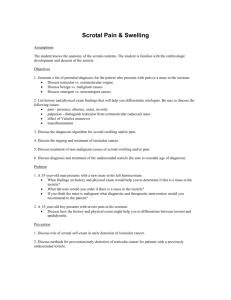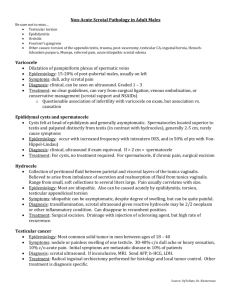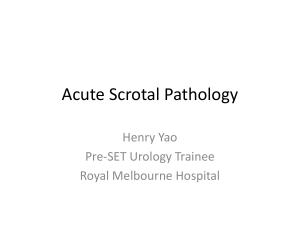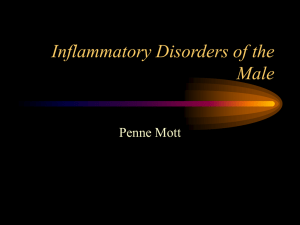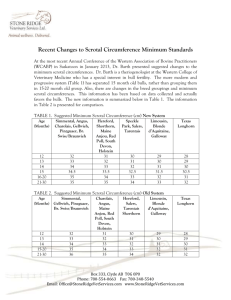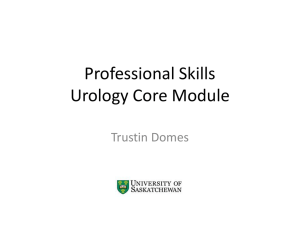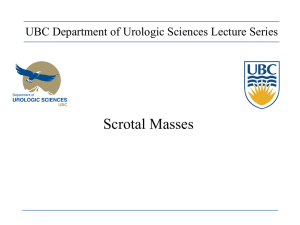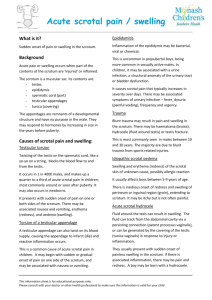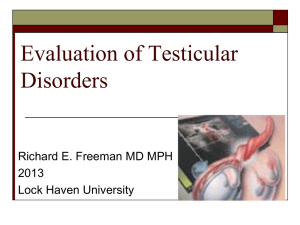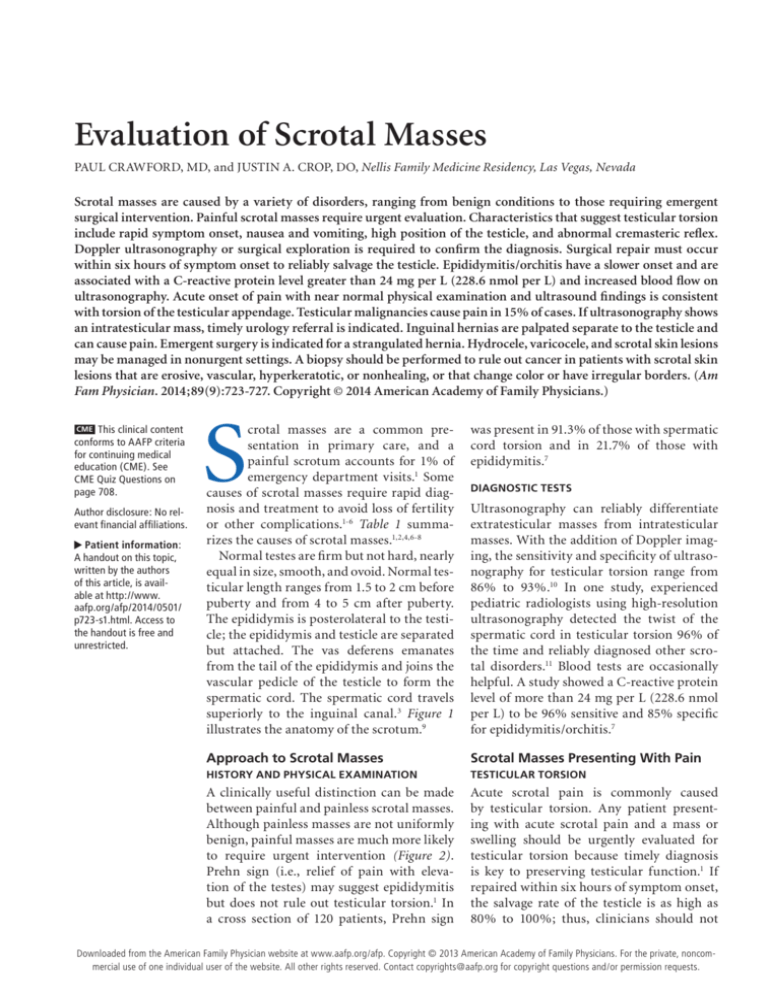
Evaluation of Scrotal Masses
PAUL CRAWFORD, MD, and JUSTIN A. CROP, DO, Nellis Family Medicine Residency, Las Vegas, Nevada
Scrotal masses are caused by a variety of disorders, ranging from benign conditions to those requiring emergent
surgical intervention. Painful scrotal masses require urgent evaluation. Characteristics that suggest testicular torsion
include rapid symptom onset, nausea and vomiting, high position of the testicle, and abnormal cremasteric reflex.
Doppler ultrasonography or surgical exploration is required to confirm the diagnosis. Surgical repair must occur
within six hours of symptom onset to reliably salvage the testicle. Epididymitis/orchitis have a slower onset and are
associated with a C-reactive protein level greater than 24 mg per L (228.6 nmol per L) and increased blood flow on
ultrasonography. Acute onset of pain with near normal physical examination and ultrasound findings is consistent
with torsion of the testicular appendage. Testicular malignancies cause pain in 15% of cases. If ultrasonography shows
an intratesticular mass, timely urology referral is indicated. Inguinal hernias are palpated separate to the testicle and
can cause pain. Emergent surgery is indicated for a strangulated hernia. Hydrocele, varicocele, and scrotal skin lesions
may be managed in nonurgent settings. A biopsy should be performed to rule out cancer in patients with scrotal skin
lesions that are erosive, vascular, hyperkeratotic, or nonhealing, or that change color or have irregular borders. (Am
Fam Physician. 2014;89(9):723-727. Copyright © 2014 American Academy of Family Physicians.)
CME This clinical content
conforms to AAFP criteria
for continuing medical
education (CME). See
CME Quiz Questions on
page 708.
Author disclosure: No relevant financial affiliations.
▲
Patient information:
A handout on this topic,
written by the authors
of this article, is available at http://www.
aafp.org/afp/2014/0501/
p723-s1.html. Access to
the handout is free and
unrestricted.
S
crotal masses are a common presentation in primary care, and a
painful scrotum accounts for 1% of
emergency department visits.1 Some
causes of scrotal masses require rapid diagnosis and treatment to avoid loss of fertility
or other complications.1-6 Table 1 summarizes the causes of scrotal masses.1,2,4,6-8
Normal testes are firm but not hard, nearly
equal in size, smooth, and ovoid. Normal testicular length ranges from 1.5 to 2 cm before
puberty and from 4 to 5 cm after puberty.
The epididymis is posterolateral to the testicle; the epididymis and testicle are separated
but attached. The vas deferens emanates
from the tail of the epididymis and joins the
vascular pedicle of the testicle to form the
spermatic cord. The spermatic cord travels
superiorly to the inguinal canal.3 Figure 1
illustrates the anatomy of the scrotum.9
was present in 91.3% of those with spermatic
cord torsion and in 21.7% of those with
epididymitis.7
Approach to Scrotal Masses
Scrotal Masses Presenting With Pain
HISTORY AND PHYSICAL EXAMINATION
TESTICULAR TORSION
A clinically useful distinction can be made
between painful and painless scrotal masses.
Although painless masses are not uniformly
benign, painful masses are much more likely
to require urgent intervention (Figure 2).
Prehn sign (i.e., relief of pain with elevation of the testes) may suggest epididymitis
but does not rule out testicular torsion.1 In
a cross section of 120 patients, Prehn sign
Acute scrotal pain is commonly caused
by testicular torsion. Any patient presenting with acute scrotal pain and a mass or
swelling should be urgently evaluated for
testicular torsion because timely diagnosis
is key to preserving testicular function.1 If
repaired within six hours of symptom onset,
the salvage rate of the testicle is as high as
80% to 100%; thus, clinicians should not
DIAGNOSTIC TESTS
Ultrasonography can reliably differentiate
extratesticular masses from intratesticular
masses. With the addition of Doppler imaging, the sensitivity and specificity of ultrasonography for testicular torsion range from
86% to 93%.10 In one study, experienced
pediatric radiologists using high-resolution
ultrasonography detected the twist of the
spermatic cord in testicular torsion 96% of
the time and reliably diagnosed other scrotal disorders.11 Blood tests are occasionally
helpful. A study showed a C-reactive protein
level of more than 24 mg per L (228.6 nmol
per L) to be 96% sensitive and 85% specific
for epididymitis/orchitis.7
◆ Volume 89, Number 9
May
1, 2014from
www.aafp.org/afp
American Academy of Family
American
Family
723
Downloaded
the American Family Physician website at www.aafp.org/afp.
Copyright © 2013
Physicians.
For thePhysician
private, noncom-
mercial use of one individual user of the website. All other rights reserved. Contact copyrights@aafp.org for copyright questions and/or permission requests.
Scrotal Masses
Table 1. Overview of the Causes of Scrotal Masses
Cause
Clinical presentation
Diagnosis
Treatment
Testicular torsion
Acute unilateral pain and swelling
Abnormal cremasteric reflex
High position of the testicle
Nausea/vomiting
See Table 2
Clinical, with or without
ultrasonography
Surgery
Epididymitis/orchitis
Acute unilateral pain and swelling
Dysuria
Erythema of the scrotal skin
Fever
Clinical, with or without
ultrasonography
Ceftriaxone (Rocephin)
and doxycycline
Torsion of the
testicular appendage
Acute unilateral pain
Blue dot sign (i.e., bluish discoloration of the
scrotum over the superior pole)
Ultrasonography
Pain control
Hematocele or
testicular rupture
History of trauma
Pain and swelling
Ultrasonography or surgical
exploration
Pain control
Surgery if needed
Testicular cancer
Firm, unilateral nodule
Ultrasonography
Tumor markers
Surgery
Inguinal hernias
Pain with Valsalva maneuvers
Unilateral bulge in the scrotum
Physical examination
Ultrasonography
Surgery
Hydrocele
Swelling
Transillumination
Ultrasonography
Pain control
Surgery if needed
Varicocele
Dull ache when standing
Scrotal mass
“Bag of worms” on
palpation
Scrotal support
Surgery if needed
Skin cancer
History of carcinogens
Erosive, vascular, hyperkeratotic, or
nonhealing; color changes; irregular border
Biopsy
Surgery
Information from references 1, 2, 4, and 6 through 8.
delay surgical consultation if diagnostic imaging is not
immediately available.12 Several history and physical
examination findings greatly increase the clinical probability that a patient has testicular torsion (Table 2).4,5,7
Torsion in infants can present with indolent symptoms—restlessness and scrotal tenderness are the hallmarks in this group.13
EPIDIDYMITIS/ORCHITIS
Epididymitis is the most common cause of scrotal pain in
adults and is characterized by acute unilateral pain and
swelling.12 The pain usually begins at the epididymis and
can spread to the entire testicle (epididymo-orchitis).14
Other symptoms include fever, erythema of the scrotal
skin, and dysuria.6 It is associated with a C-reactive protein level greater than 24 mg per L and increased blood
flow on ultrasonography. Chlamydia trachomatis and
Neisseria gonorrhoeae are the most common organisms
responsible for bacterial epididymitis in males younger
724 American Family Physician
than 35 years. Guidelines recommend empiric ceftriaxone (Rocephin) and doxycycline for treatment of suspected epididymitis in males younger than 35 years.8
TORSION OF THE TESTICULAR APPENDAGE
Torsion of the testicular appendage at the superior pole
of the testicle is an intensely painful, self-limited disorder most common in prepubertal males.15 The condition
presents as acute unilateral pain without a high testicle
or signs of epididymitis. The blue dot sign (i.e., bluish
discoloration of the scrotum over the superior pole) is
a specific finding for torsion of the testicular appendage
but is not sensitive. Ultrasonography is helpful to rule
out testicular torsion, but if results are inconclusive, a
surgeon should explore the scrotum.1
HEMATOCELE OR TESTICULAR RUPTURE
Severe scrotal trauma can rarely result in hematoma or
rupture of the testicle. Therefore, patients with a history
www.aafp.org/afp
Volume 89, Number 9
◆
May 1, 2014
Spermatic cord
of trauma and scrotal pain should always
undergo ultrasonography.16
Scrotal Masses Presenting With
or Without Pain
Approximately 95% of all testicular tumors
in adults are derived from the germ cells.
They are categorized as seminomatous or
Vas deferens
nonseminomatous germ cell tumors, and
Pampiniform
are the most common cancers diagnosed in
plexus
males 15 to 34 years of age. These tumors
Head of the
are five times more common in whites than
epididymis
Epididymis
in blacks.6
Testicular
Testicular malignancies cause pain in 15%
Testicle (covered by
appendage
1
visceral layer of tunica
of cases. Testicular cancer usually presents as
Parietal layer of
vaginalis testis)
a firm, unilateral nodule.6 Testicular masses
tunica vaginalis
17
in children are likely to be malignant. Risk
testis
factors for testicular cancer include cryptorchidism (undescended testicle), family or
Tail of epididymis
personal history of testicular cancer, Klinefelter syndrome, and previous orchitis.3,12,18
When cancer is a concern in a patient
with a testicular mass, laboratory testing includes α-fetoprotein, beta subunit of Figure 1. Anatomy of the scrotum.
human chorionic gonadotropin, and lacReprinted with permission from Tiemstra JD, Kapoor S. Evaluation of scrotal masses. Am
tate dehydrogenase levels.6 Urgent referral Fam Physician. 2008;78(10):1167.
to a urologist is indicated for patients with
intratesticular masses, even though smaller masses are VARICOCELE
less likely to be cancerous.19,20 There is new evidence that A varicocele is a dilation of the venous pampiniform
testicular sparing surgery may be satisfactory in selected plexus of the spermatic cord, which coalesces into a sinpatients.21
gle testicular vein. Varicoceles are classically described
as feeling like a bag of worms; this feeling increases
INGUINAL HERNIAS
with Valsalva maneuvers. Varicoceles occur in 15% of
Inguinal hernias may contain fat or colon and are eas- males and usually first appear in adolescence.17 There
ily diagnosed based on physical examination results and is conflicting evidence about the association between
clinical history.18 Valsalva maneuvers performed while varicoceles and male infertility. A Cochrane review of 10
palpating the inguinal canal will push a hernia against randomized trials found some increase in fertility from
the examiner’s finger. Strangulated hernias are a surgi- surgical treatment of varicoceles in couples with unexcal emergency. Patients with hernias that cause signifi- plained subfertility (number needed to treat = 17).22
cant pain should also be referred for possible surgical
LESS COMMON INTRASCROTAL MASSES
correction.
Spermatoceles and epididymal cysts are benign, nonpainScrotal Masses Presenting Without Pain
ful masses that are usually palpated in the spermatic cord.
HYDROCELE
Hydroceles can be differentiated from other testicular
masses by transillumination of the fluid with a penlight. Patients with hydroceles also have a palpably normal spermatic cord and inguinal ring above the swollen
area. Scrotal ultrasonography may be helpful in making
the diagnosis.6,18
May 1, 2014
◆
Volume 89, Number 9
SCROTAL WALL MASSES
Occasionally, a scrotal wall lesion presents as a scrotal
mass. Scrotal skin cancer is more common in persons
with a history of psoralen plus ultraviolet A therapy or
human papillomavirus infection. Scrotal skin lesions
that are erosive, vascular, hyperkeratotic, or nonhealing,
www.aafp.org/afp
American Family Physician 725
ILLUSTRATION BY TODD BUCK
TESTICULAR CANCER
Scrotal Masses
Evaluation of a Scrotal Mass
Scrotal mass
Painful
Nonpainful
Transilluminates?
High-riding or horizontal
testicle, nausea/vomiting?
Yes
Yes
No
Presumed torsion:
Doppler ultrasonography,
urology consultation
No
Hydrocele
Blue dot sign?
“Bag of worms” on palpation that
increases with Valsalva maneuvers?
Yes
Yes
No
No
Torsion of testicular
appendage
Varicocele
Lack of blood flow on Doppler
ultrasonography, C-reactive protein
level < 24 mg per L (228.6 nmol per L)?
Reducible mass?
Yes
Hernia
Yes
Testicular torsion: urgent
surgical evaluation
No
Likely epididymitis/orchitis,
possibly incarcerated inguinal
hernia or hemorrhagic
testicular cancer
No
Extratesticular
and nontender?
Yes
Likely benign; further
workup as needed
No
Doppler ultrasonography
prior to urology evaluation
Unilateral mass
Evaluate for testicular cancer: α-fetoprotein, beta subunit of human chorionic
gonadotropin, and lactate dehydrogenase levels; magnetic resonance imaging
or computed tomography may be considered to look for possible metastases
and cryopreservation of sperm while awaiting urology evaluation
Figure 2. Algorithm for diagnosing the cause of a scrotal mass.
Table 2. History and Physical Findings Associated
With Testicular Torsion
Finding
History
Nausea and vomiting
Symptom duration < 24 hours
Physical examination
C-reactive protein level < 24 mg per L
(228.6 nmol per L)
High position of the testicle
Abnormal cremasteric reflex
Blue dot sign
Information from references 4, 5, and 7.
726 American Family Physician
Odds ratio
8.9 to 21.6
4.2 to 6.7
124.1
18 to 58.8
4.8 to 27.8
0.37
or that change color, or have irregular borders should
be biopsied to rule out cancer.23,24 Fournier gangrene is
a necrotizing soft tissue infection that can present as a
scrotal mass and is a surgical emergency.25 Benign scrotal
masses include genital warts, benign nevus, epidermal
cysts, seborrheic keratosis, and angiokeratomas.
INCIDENTAL INTRATESTICULAR MASS
Nonpalpable intratesticular masses found incidentally
on a male infertility evaluation should prompt measurement of α-fetoprotein, beta subunit of human chorionic
gonadotropin, and lactate dehydrogenase. An incidental
mass less than 5 mm in diameter in a patient with negative serum tumor markers is likely benign.20 In patients
with larger or enlarging masses, excisional biopsy that
spares the testicle is prudent to rule out testicular cancer
(if positive, orchiectomy should be performed).19
www.aafp.org/afp
Volume 89, Number 9
◆
May 1, 2014
Scrotal Masses
SORT: KEY RECOMMENDATIONS FOR PRACTICE
Clinical recommendation
Epididymitis/orchitis should be suspected in patients with testicular pain and a C-reactive protein
level of more than 24 mg per L (228.6 nmol per L).
Any patient presenting with acute scrotal pain and a mass or swelling should be evaluated for testicular
torsion by scrotal ultrasonography or surgical exploration within six hours of symptom onset.
Testicular torsion should be suspected in patients with rapid onset of acute unilateral scrotal pain and
swelling, nausea or vomiting, high position of the testicle, and an abnormal cremasteric reflex.
Evidence
rating
References
C
7
C
1, 12
C
1, 12
A = consistent, good-quality patient-oriented evidence; B = inconsistent or limited-quality patient-oriented evidence; C = consensus, diseaseoriented evidence, usual practice, expert opinion, or case series. For information about the SORT evidence rating system, go to http://www.aafp.
org/afpsort.
Data Sources: A PubMed search was completed in Clinical Queries
using the key terms scrotal mass, acute scrotum, scrotum mass, testicular cancer, and imaging scrotum. The search included meta-analyses,
randomized controlled trials, clinical trials, and reviews. Also searched
were the Agency for Healthcare Research and Quality evidence reports,
Bandolier, Clinical Evidence, the Cochrane database, Database of
Abstracts of Reviews of Effects, Essential Evidence Plus, the Institute
for Clinical Systems Improvement, the National Guideline Clearinghouse
database, the Trip database, and UpToDate. Search dates: January 18,
2012; April 4, 2012; and January 13, 2014.
The opinions and assertions contained herein are the private views of the
authors and are not to be construed as official or as reflecting the views
of the U.S. Army, Navy, or Air Force Medical Departments or the U.S.
Army, Navy, Air Force, or Public Health Service.
The Authors
PAUL CRAWFORD, MD, is program director of the Nellis Family Medicine
Residency in Las Vegas, Nev. He is an associate professor at the Uniformed
Services University of the Health Sciences in Bethesda, Md.
JUSTIN A. CROP, DO, is a faculty member at the Nellis Family Medicine
Residency. He is an assistant professor at the Uniformed Services University of the Health Sciences.
Address correspondence to Paul Crawford, MD, Nellis Family Medicine
Residency, 4700 Las Vegas Blvd. N, Nellis AFB, NV 89191 (e-mail: paul.
crawford@us.af.mil). Reprints are not available from the authors.
8.Tracy CR, Steers WD, Costabile R. Diagnosis and management of epididymitis. Urol Clin North Am. 2008;35(1):101-108.
9. Tiemstra JD, Kapoor S. Evaluation of scrotal masses. Am Fam Physician.
2008;78(10):1165-1170.
10.Akin EA, Khati NJ, Hill MC. Ultrasound of the scrotum. Ultrasound Q.
2004;20(4):181-200.
11.Kalfa N, Veyrac C, Lopez M, et al. Multicenter assessment of ultrasound of the spermatic cord in children with acute scrotum. J Urol.
2007;177(1):297-301.
12.Cokkinos DD, Antypa E, Tserotas P, et al. Emergency ultrasound of the
scrotum: a review of the commonest pathologic conditions. Curr Probl
Diagn Radiol. 2011;40(1):1-14.
13.Mano R, Livne PM, Nevo A, Sivan B, Ben-Meir D. Testicular torsion in
the first year of life—characteristics and treatment outcome. Urology.
2013;82(5):1132-1137.
14.Workowski KA, Berman S; Centers for Disease Control and Prevention.
Sexually transmitted diseases treatment guidelines, 2010 [published
correction appears in MMWR Recomm Rep. 2011;60(1):18]. MMWR
Recomm Rep. 2010;59(RR-12):1-110.
15.Mäkelä E, Lahdes-Vasama T, Rajakorpi H, Wikström S. A 19-year
review of paediatric patients with acute scrotum. Scand J Surg. 2007;
96(1):62-66.
16.Buckley JC, McAninch JW. Use of ultrasonography for the diagnosis of
testicular injuries in blunt scrotal trauma. J Urol. 2006;175(1):175-178.
17.Yuan X, Wei G, Lin T, He D, Li X. Uncommon pediatric painless scrotal masses: a puzzle of pediatricians and urologists. Int Urol Nephrol.
2010;42(4):979-984.
18.Winter TC. There is a mass in the scrotum—what does it mean?: Evaluation of the scrotal mass. Ultrasound Q. 2009;25(4):195-205.
REFERENCES
19. Powell TM, Tarter TH. Management of nonpalpable incidental testicular
masses. J Urol. 2006;176(1):96-98.
1. Davis JE, Silverman M. Scrotal emergencies. Emerg Med Clin North Am.
2011;29(3):469-484.
20.Eifler JB Jr, King P, Schlegel PN. Incidental testicular lesions found during
infertility evaluation are usually benign and may be managed conservatively. J Urol. 2008;180(1):261-264.
2.Molokwu CN, et al. Outcomes of scrotal exploration for acute scrotal
pain suspicious of testicular torsion. BJU Int. 2011;107(6):990-993.
3.Tajchner L, Larkin JO, Bourke MG, Waldron R, Barry K, Eustace PW.
Management of the acute scrotum in a district general hospital: 10-year
experience. ScientificWorldJournal. 2009;9:281-286.
21. Gentile G, Brunocilla E, Franceschelli A, et al. Can testis-sparing surgery
for small testicular masses be considered a valid alternative to radical
orchiectomy? A prospective single-center study. Clin Genitourin Cancer.
2013;11(4):522-526.
4. Beni-Israel T, Goldman M, Bar Chaim S, Kozer E. Clinical predictors for
testicular torsion as seen in the pediatric ED. Am J Emerg Med. 2010;
28(7):786-789.
22.Kroese AC, de Lange NM, Collins J, Evers JL. Surgery or embolization
for varicoceles in subfertile men. Cochrane Database Syst Rev. 2012;
(10):CD000479.
5. Boettcher M, Bergholz R, Krebs TF, Wenke K, Aronson DC. Clinical predictors of testicular torsion in children. Urology. 2012;79(3):670-674.
23.de la Brassinne M, Richert B. Genital squamous-cell carcinoma after
PUVA therapy. Dermatology. 1992;185(4):316-318.
6. Montgomery JS, Bloom DA. The diagnosis and management of scrotal
masses. Med Clin North Am. 2011;95(1):235-244.
24.Eliezri YD, Silverstein SJ, Nuovo GJ. Occurrence of human papillomavirus
type 16 DNA in cutaneous squamous and basal cell neoplasms. J Am
Acad Dermatol. 1990;23(5 pt 1):836-842.
7.Asgari SA, Mokhtari G, Falahatkar S, et al. Diagnostic accuracy of
C-reactive protein and erythrocyte sedimentation rate in patients with
acute scrotum. Urol J. 2006;3(2):104-108.
May 1, 2014
◆
Volume 89, Number 9
25.Anaya DA, Dellinger EP. Necrotizing soft-tissue infection: diagnosis and
management. Clin Infect Dis. 2007;44(5):705-710.
www.aafp.org/afp
American Family Physician 727

